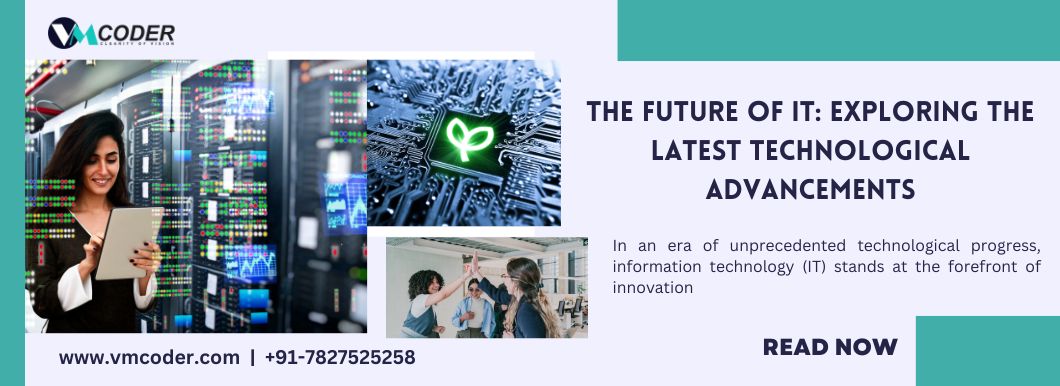The Future of IT: Exploring the Latest Technological Advancements
Introduction
In an era of unprecedented technological progress, information technology (IT) stands at the forefront of innovation. From the integration of artificial intelligence and machine learning to the rollout of 5G networks and the promising potential of quantum computing, IT is shaping the future in profound ways. In this blog post, we'll embark on a journey to explore the latest technological advancements in the world of IT and envision the transformative impact they will have on our lives.
The Power of Artificial Intelligence (AI) and Machine Learning (ML)
Artificial Intelligence and Machine Learning have been making waves in recent years. These technologies empower machines to analyse data, learn from it, and make intelligent decisions, mimicking human cognitive functions. From virtual assistants like Siri and Alexa to recommendation systems on streaming platforms, AI and ML are embedded in our daily lives.
But the applications go far beyond that. AI is revolutionising healthcare with the ability to diagnose diseases and predict patient outcomes. It's helping financial institutions detect fraudulent activities and providing personalised investment advice. Marketing and e-commerce are benefitting from AI's ability to analyse consumer behaviour and offer tailored product recommendations.
The future of AI and ML holds even greater promises. With ongoing advancements, we can expect to see more autonomous vehicles on our roads, enhanced natural language processing for seamless human-computer interaction, and breakthroughs in drug discovery and genomics. AI is poised to continue shaping and streamlining our lives in previously unimaginable ways.
5G Technology: Redefining Connectivity
The rollout of 5G networks represents a monumental leap in the world of connectivity. This fifth-generation wireless technology promises speeds up to 100 times faster than 4G, significantly reduced latency, and the ability to connect billions of devices simultaneously. With 5G, the Internet of Things (IoT) is set to flourish.
5G is the catalyst for the development of smart cities, where interconnected sensors and devices improve urban living through optimised transportation, energy efficiency, and security. Autonomous vehicles will depend on 5G for real-time communication, enabling them to navigate streets and highways safely. Remote surgery, powered by ultra-low latency, is on the horizon. Moreover, 5G is a game-changer for remote work, making it possible for employees to access and share data seamlessly from anywhere in the world.
Quantum Computing: A Leap into the Unknown
Quantum computing is on the brink of revolutionising computational power. Unlike classical computers that use binary bits (0s and 1s), quantum computers employ qubits, which can exist in multiple states simultaneously due to the principles of quantum mechanics. This allows quantum computers to perform complex calculations at a speed that is currently unattainable with classical computers.
Industries such as cryptography, drug discovery, and materials science will be profoundly impacted by quantum computing. For example, the cryptographic systems that secure our online transactions could be compromised in seconds by quantum computers. However, quantum computing also offers solutions, with the potential to develop unbreakable quantum-resistant encryption methods.
While practical quantum computers for everyday use are not yet a reality, research and development are progressing rapidly. In the future, we might see quantum computing as a service, offering unprecedented computational power for solving complex problems.
Blockchain and Cryptocurrency: Beyond Digital Money
Blockchain technology, initially developed for cryptocurrencies like Bitcoin, has found applications far beyond digital currency. A blockchain is a distributed ledger that records transactions across a network of computers, ensuring transparency and security.
Blockchain's decentralised nature makes it ideal for supply chain management. It enables companies and consumers to trace the origin of products, verify authenticity, and ensure ethical sourcing. Blockchain can also transform voting systems, making elections more secure, transparent, and accessible.
Cryptocurrencies, as digital assets, are gaining mainstream acceptance and are seen as a store of value, much like traditional assets. Moreover, they enable cross-border transactions at a fraction of the cost and time associated with traditional banking systems.
Edge Computing: Processing Power at the Source
Edge computing is a paradigm shift in data processing. Instead of sending data to a centralised cloud server for analysis, edge computing processes data closer to its source. This reduces latency and allows for real-time data analysis and decision-making.
With the increasing number of IoT devices and the need for quick, localised responses, edge computing is gaining traction. Applications include autonomous vehicles that need immediate reaction times, industrial automation for manufacturing, and augmented reality experiences.
Cybersecurity Advancements: Safeguarding the Digital World
As technology advances, so do the threats. Cybersecurity remains a top priority in IT. Advancements include AI-driven threat detection, which can identify and respond to cyber threats more effectively than human experts. Zero-trust security models are gaining popularity, where trust is never assumed, even within a network.
Improved identity and access management solutions are emerging, ensuring that only authorised users have access to critical systems. As remote work and cloud adoption continue to rise, robust cybersecurity measures are essential to protect sensitive data and infrastructure.
Augmented and Virtual Reality (AR/VR): Immersive Experiences
AR and VR technologies are revolutionising entertainment, education, and various industries. Augmented Reality overlays digital information onto the physical world, while Virtual Reality immerses users in a completely digital environment.
In the gaming world, AR and VR are delivering immersive experiences that blur the line between reality and digital worlds. In education, students can explore historical events through VR field trips or interact with 3D models in AR. Healthcare professionals are using AR for surgery planning and training.
Conclusion: The Future is Here
The latest technological advancements in IT are nothing short of astounding. From AI and 5G to quantum computing and blockchain, these innovations are transforming our world. They have the potential to redefine industries, improve our daily lives, and unlock new possibilities we have yet to imagine.
The future of IT is a future of constant evolution, where breakthroughs in technology will continue to shape and redefine our world. As we embrace these advancements and learn how to harness their power, the possibilities are limitless. The future of IT is not a distant dream; it is here, and it is now. It's a future where technology isn't just a tool; it's a partner in our progress, a guide to our aspirations, and a window into the infinite potential of human innovation.
Leave a Reply
Your email address will not be published. Required fields are marked *





